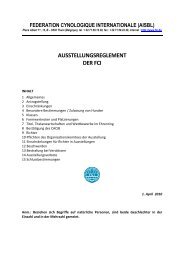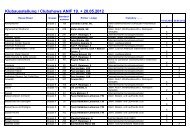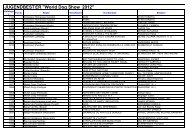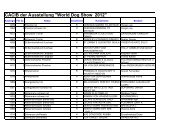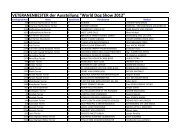Rules for Heelwork to Music (HTM) and Freestyle - World Dog Show
Rules for Heelwork to Music (HTM) and Freestyle - World Dog Show
Rules for Heelwork to Music (HTM) and Freestyle - World Dog Show
You also want an ePaper? Increase the reach of your titles
YUMPU automatically turns print PDFs into web optimized ePapers that Google loves.
General <strong>Rules</strong><br />
<strong>Rules</strong> <strong>HTM</strong> & <strong>Freestyle</strong><br />
� All dogs must be registered in a kennel organisation approved by FCI.<br />
� All dogs are shown at the exhibi<strong>to</strong>r’s own account <strong>and</strong> risk. The organizer cannot be<br />
held liable <strong>for</strong> damages caused by dogs or exhibi<strong>to</strong>rs.<br />
� <strong>Dog</strong>s must be vaccinated against distemper <strong>and</strong> parvovirus. Foreign dogs must also<br />
be vaccinated against rabies according <strong>to</strong> Austrian legislation.<br />
� In Austria all cropped or docked dogs born after 1 January 2008 cannot compete<br />
(regardless of the dog’s country of birth). The prohibition also includes dogs that have<br />
been docked <strong>for</strong> veterinary reasons, irrespective a veterinary certificate is presented.<br />
� The participation of dogs with <strong>to</strong>rtured breeding characteristics (<strong>for</strong> example dogs with<br />
difficulty in breathing, hairless dogs with a strong <strong>to</strong>oth outnumbered or <strong>to</strong>othless) is<br />
prohibited!<br />
� <strong>Dog</strong>s competing must be at least 18 months old on the day of the competition.<br />
In the ring<br />
� No activity should be conducted which may injure the dog.<br />
� Once a dog has entered the ring <strong>to</strong> compete, no further practise is permitted.<br />
� The team is under judge’s orders from entering the ring <strong>to</strong> leaving it. All requests from<br />
the judges must be followed.<br />
Judging:<br />
� The competition will be judged by 3 judges. One judge will be from Engl<strong>and</strong>, the<br />
others from 2 different countries.<br />
� The judge’s points will be added, then divided by 3 – in other words the average<br />
points of the 3 judges will be the final score.<br />
� The judge’s decision cannot be appealed.<br />
� One judge is appointed “head judge”. This judge will have the final word when<br />
agreement cannot be reached.<br />
� In any case of doubt, the head judge will have the final word.<br />
In case of equal points:<br />
� <strong>Heelwork</strong> <strong>to</strong> music:<br />
o If 2 dogs have equal points in the <strong>Heelwork</strong> <strong>to</strong> <strong>Music</strong> competition, the dog with<br />
the highest points in “Presentation” wins.<br />
o If they still have equal points the dog with the highest points in “Degree of<br />
Difficulty” wins.<br />
o If they still have equal points, the head judge will decide the winner.<br />
� <strong>Freestyle</strong>:<br />
o If 2 dogs have equal points in the <strong>Freestyle</strong> competition, the dog with the<br />
highest points in “<strong>Music</strong> an Interpretation” wins.<br />
o If they still have equal points the dog with the highest points in “Presentation”<br />
wins.<br />
o If they still have equal points, the head judge will decide the winner.<br />
Competition rules:<br />
� In<strong>for</strong>mation about ring size <strong>and</strong> where the judges will be seated must be available <strong>to</strong><br />
competi<strong>to</strong>rs at the least 2 month prior <strong>to</strong> the competition.
� Be<strong>for</strong>e the h<strong>and</strong>ler <strong>and</strong> dog begin their routine, the h<strong>and</strong>ler must acknowledge the<br />
judges at the table by bowing, curtseying or “nodding”. The dog can do a quick move,<br />
but this should not take more than a few seconds <strong>to</strong> complete.<br />
� The dog is not allowed <strong>to</strong> be in costume or fancy dress. A decorated collar is<br />
permitted. If you are in doubt of what is allowed, ask at the briefing be<strong>for</strong>e the<br />
competition commences.<br />
� The dog must be off lead in the ring.<br />
� No food or <strong>to</strong>ys are allowed in the ring.<br />
� Props can be used if they are appropriate <strong>to</strong> the choice of music <strong>and</strong> incorporated in<br />
the routine. It is the h<strong>and</strong>ler’s responsibility <strong>to</strong> bring a helper that will place the prop in<br />
the ring prior <strong>to</strong> the competition.<br />
Bitches in season:<br />
� Bitches in season are allowed <strong>to</strong> compete but must be kept away from the<br />
competition area until all the other routines are completed.<br />
� Bitches in season compete at the end of the competition.<br />
� The organisers must be notified that a bitch is in season as soon as possible <strong>and</strong> no<br />
later than at the morning briefing.<br />
<strong>Music</strong>:<br />
To avoid errors <strong>and</strong> misunderst<strong>and</strong>ings regarding the music, the following rules will be<br />
adhered <strong>to</strong>:<br />
� Must be send <strong>to</strong> us with the entry <strong>for</strong>m.<br />
� It is the h<strong>and</strong>ler’s responsibility <strong>to</strong> h<strong>and</strong> in a CD, which only contains the track/version<br />
of the music they <strong>to</strong> per<strong>for</strong>m <strong>to</strong>.<br />
� It is the h<strong>and</strong>ler’s responsibility <strong>to</strong> bring a back-up CD in case there is an error on the<br />
original CD.<br />
� If a h<strong>and</strong>ler competes in <strong>HTM</strong> <strong>and</strong> <strong>Freestyle</strong>, the h<strong>and</strong>ler must h<strong>and</strong> in a CD <strong>for</strong> each<br />
discipline (one CD <strong>for</strong> each routine).<br />
� If a h<strong>and</strong>ler competes with several dogs, a CD <strong>for</strong> each dog <strong>and</strong> class must be<br />
h<strong>and</strong>ed in.<br />
� If the music is longer than the routine, the music will be s<strong>to</strong>pped when the h<strong>and</strong>ler<br />
CLEARLY signals the routine is completed.<br />
� Is the music s<strong>to</strong>ps during a routine the competi<strong>to</strong>r must be given the opportunity <strong>to</strong><br />
complete the routine. The h<strong>and</strong>ler’s back up CD may be used <strong>and</strong>/or alternative<br />
equipment, if this was the reason <strong>for</strong> failure. The judges will continue marking from<br />
the point at which the music s<strong>to</strong>pped.<br />
� If the music s<strong>to</strong>ps during a routine, the h<strong>and</strong>ler can choose not <strong>to</strong> complete the<br />
routine <strong>and</strong> be judged solely on the part of the routine per<strong>for</strong>med prior <strong>to</strong> the music<br />
s<strong>to</strong>pping.<br />
� The length of the music may be up <strong>to</strong> 4 minutes.<br />
Disqualification - a h<strong>and</strong>ler <strong>and</strong> dog will be disqualified if:<br />
� The dog is on lead in the ring.<br />
� The h<strong>and</strong>ler has food or a <strong>to</strong>y in the ring.<br />
� The h<strong>and</strong>ler practises harsh h<strong>and</strong>ling.<br />
� The dog relieves itself in the ring.<br />
� The dog is out of control in the ring.<br />
� The dog leaves the ring be<strong>for</strong>e routine is completed.
Other things that will reduce points:<br />
� If the dog barks continuously or <strong>for</strong> the greater part of the routine. If the barking<br />
disturbs the presentation of the routine.<br />
� If the h<strong>and</strong>ler physically manipulates or holds the dog in a position/move.<br />
In general, the rules from the Austrian Kennel Club must be followed.<br />
HEELWORK TO MUSIC<br />
The maximum time limit <strong>for</strong> the duration of the routine is 4 minutes.<br />
<strong>Heelwork</strong> <strong>to</strong> <strong>Music</strong> is, as the name suggests, “<strong>Heelwork</strong> <strong>to</strong> <strong>Music</strong>”. The routine must<br />
there<strong>for</strong>e consist of least 75% heelwork.<br />
The dog must stay within 2 metres of the h<strong>and</strong>ler at all times.<br />
<strong>Heelwork</strong><br />
The following positions are considered <strong>to</strong> be heelwork in <strong>HTM</strong>:<br />
The dog has his right shoulder parallel with the h<strong>and</strong>ler’s left leg.<br />
The dog has his left shoulder parallel with the h<strong>and</strong>ler’s right leg.<br />
The dog has his right shoulder parallel with the h<strong>and</strong>ler’s right leg facing opposite the<br />
h<strong>and</strong>ler. The dog has his left shoulder parallel with the h<strong>and</strong>ler’s left leg facing opposite the<br />
h<strong>and</strong>ler.<br />
The dog between the h<strong>and</strong>ler’s legs with both shoulders parallel <strong>to</strong> the h<strong>and</strong>ler’s legs.<br />
In front of, with his side <strong>to</strong> the h<strong>and</strong>ler.<br />
Behind, with his side <strong>to</strong> the h<strong>and</strong>ler.<br />
These positions must be kept the same in movement – the dog must not jump/bounce or<br />
“crab” <strong>to</strong> keep the position by the h<strong>and</strong>ler.<br />
The dogs body should be straight, <strong>and</strong> parallel <strong>to</strong> the h<strong>and</strong>ler.<br />
The dog must not move in 2 tracks during heelwork, sideways movement is the exception <strong>to</strong><br />
this rule.<br />
The dog must keep the same distance in relation <strong>to</strong> the h<strong>and</strong>ler in all positions.<br />
The dog must move in the same direction as the h<strong>and</strong>ler.<br />
The dog must follow the h<strong>and</strong>ler’s choice of place.<br />
FREESTYLE<br />
The maximum time limit <strong>for</strong> the duration of the routine is 4 minutes.<br />
There is no requirement <strong>to</strong> heelwork or other specific moves in the freestyle competition,<br />
however it should be clear <strong>to</strong> the judges that it is a freestyle routine an the amount of<br />
heelwork should not exceed 25% of the routine.<br />
Moves are defined as anything that is heelwork (<strong>for</strong> a definition of heelwork, see above).
Points are given according <strong>to</strong> the following:<br />
Presentation – MAXIMUM SCORE: 10 points<br />
� Cooperation <strong>and</strong> coordination between dog <strong>and</strong> h<strong>and</strong>ler – The routine should clearly<br />
demonstrate the dog’s <strong>and</strong> h<strong>and</strong>ler’s attentiveness <strong>to</strong> each other – so the<br />
coordination/cooperation in the routine is as fluent as possible.<br />
� Presentation – The routine flows naturally without abrupt breaks/s<strong>to</strong>ps, the dog <strong>and</strong><br />
h<strong>and</strong>ler are confident in their per<strong>for</strong>mance <strong>and</strong> know their routine.<br />
The h<strong>and</strong>ler/dog makes the per<strong>for</strong>mance seem easy.<br />
� Signals – The signals between dog/h<strong>and</strong>ler are discrete <strong>to</strong> they are put in<strong>to</strong> the<br />
choreography so they do not distract from the routine.<br />
� Focus on the dog – The routine is per<strong>for</strong>med so the focus is on the dog or teamwork.<br />
It is not the h<strong>and</strong>ler who should attract attention.<br />
� <strong>Show</strong> quality – The team has appeal <strong>and</strong> per<strong>for</strong>ms an excellent routine that appeals<br />
<strong>to</strong> the judges <strong>and</strong> the audience. The h<strong>and</strong>ler’s per<strong>for</strong>mance is appropriate <strong>for</strong> a family<br />
audience.<br />
� Any other items which may be relevant <strong>to</strong> the per<strong>for</strong>mance <strong>and</strong> content of the routine.<br />
Degree of difficulty (Technical Merit) – MAXIMUM SCORE: 10 points<br />
� Amount of moves or heelwork – The number of moves <strong>and</strong> contents of the routine is<br />
appropriate <strong>to</strong> the music – not <strong>to</strong>o many in a short period of time, or <strong>to</strong>o little <strong>to</strong> “fill”<br />
the time.<br />
� Quality <strong>and</strong> degree of difficulty of heelwork or moves – The more precise, difficult <strong>and</strong><br />
the higher the quality of the moves or heelwork the higher the points.<br />
� Choreography – The choreography is designed so the heelwork <strong>and</strong> moves have no<br />
abrupt s<strong>to</strong>ps but are integrated smoothly – <strong>and</strong> the routine is made <strong>to</strong> suit the dog<br />
<strong>and</strong> its movement. The choreography varies so the routine is interesting.<br />
� Use of available ring space – Routines should make a good use of the available ring<br />
space.<br />
� Any other items which may be relevant <strong>to</strong> the degree of difficulty <strong>and</strong> technical merit<br />
of the routine.<br />
<strong>Music</strong> <strong>and</strong> interpretation – MAXIMUM SCORE: 10 points<br />
� Interpretation of the music – The music is interpreted. Steady/emotional presentation<br />
<strong>to</strong> emotional music – enthusiastic/powerful presentation <strong>to</strong> music with more power.<br />
� If the music tells a s<strong>to</strong>ry, it should be incorporated in the routine.<br />
� Is the routine suited <strong>to</strong> the music? The routine is in harmony with the music. All the<br />
moves are based on the music <strong>and</strong> the inspiration from the music. The routine is<br />
created <strong>and</strong> presented so the dog’s movement, the h<strong>and</strong>ler’s movement <strong>and</strong> music<br />
become one.<br />
� Is the music suited <strong>to</strong> the dog? The music is suited <strong>to</strong> the dogs speed, movement <strong>and</strong><br />
enthusiasm.<br />
� Any other items which may be relevant <strong>to</strong> the degree of difficulty <strong>and</strong> technical merit<br />
of the routine.



